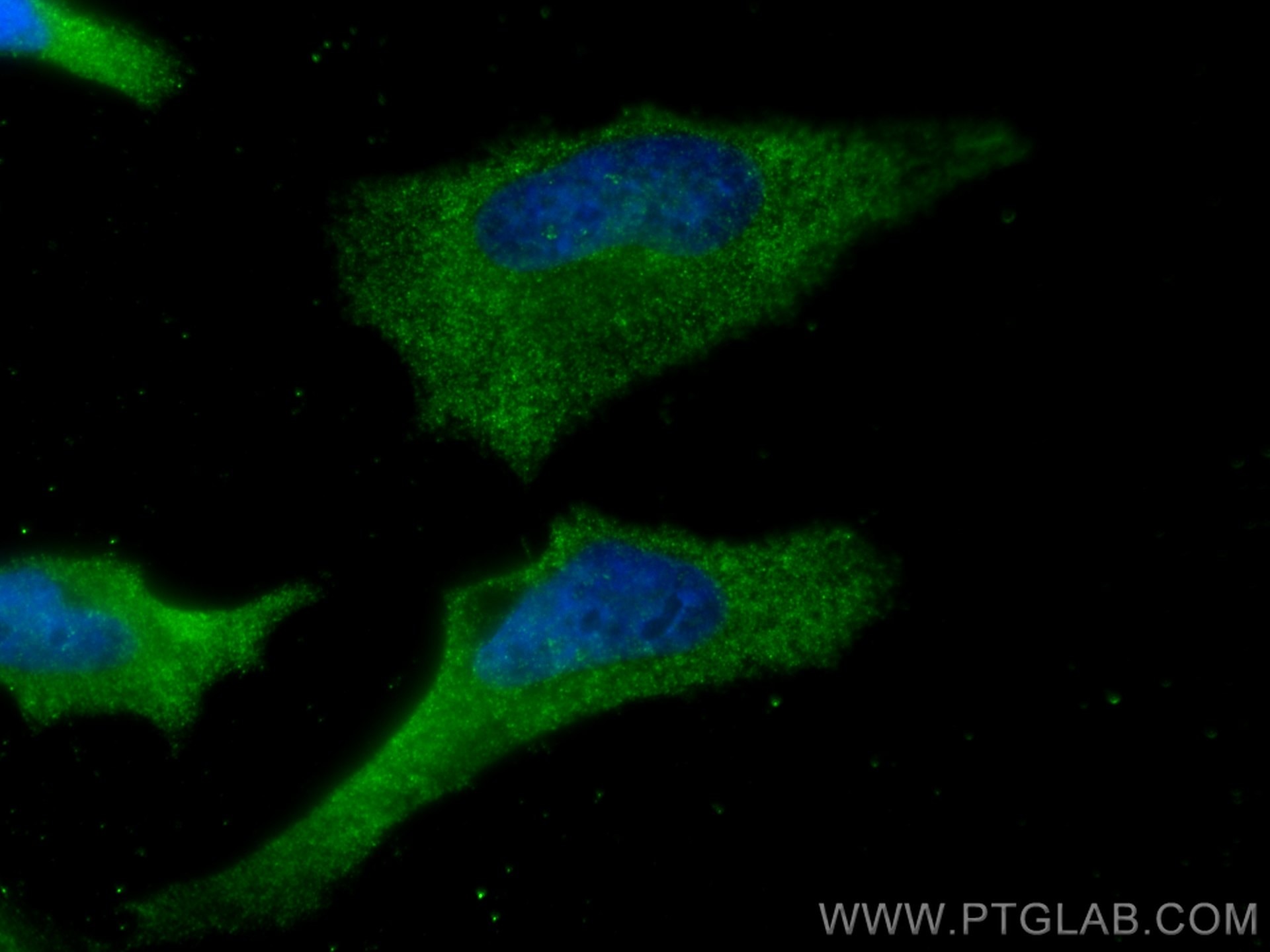- Featured Product
- KD/KO Validated
USP9X Polyklonaler Antikörper
USP9X Polyklonal Antikörper für IF, IHC, IP, WB, ELISA
Wirt / Isotyp
Kaninchen / IgG
Getestete Reaktivität
human, Maus, Ratte und mehr (1)
Anwendung
WB, IP, IHC, IF, CoIP, ELISA
Konjugation
Unkonjugiert
Kat-Nr. : 55054-1-AP
Synonyme
Galerie der Validierungsdaten
Geprüfte Anwendungen
| Erfolgreiche Detektion in WB | HEK-293-Zellen, HeLa-Zellen, K-562-Zellen, Maushirngewebe, Rattenhirngewebe |
| Erfolgreiche IP | HeLa-Zellen |
| Erfolgreiche Detektion in IHC | humanes Pankreaskarzinomgewebe Hinweis: Antigendemaskierung mit TE-Puffer pH 9,0 empfohlen. (*) Wahlweise kann die Antigendemaskierung auch mit Citratpuffer pH 6,0 erfolgen. |
| Erfolgreiche Detektion in IF | HeLa-Zellen |
Empfohlene Verdünnung
| Anwendung | Verdünnung |
|---|---|
| Western Blot (WB) | WB : 1:5000-1:50000 |
| Immunpräzipitation (IP) | IP : 0.5-4.0 ug for 1.0-3.0 mg of total protein lysate |
| Immunhistochemie (IHC) | IHC : 1:50-1:500 |
| Immunfluoreszenz (IF) | IF : 1:200-1:800 |
| It is recommended that this reagent should be titrated in each testing system to obtain optimal results. | |
| Sample-dependent, check data in validation data gallery | |
Veröffentlichte Anwendungen
| KD/KO | See 14 publications below |
| WB | See 23 publications below |
| IHC | See 4 publications below |
| IF | See 5 publications below |
| IP | See 5 publications below |
| CoIP | See 3 publications below |
Produktinformation
55054-1-AP bindet in WB, IP, IHC, IF, CoIP, ELISA USP9X und zeigt Reaktivität mit human, Maus, Ratten
| Getestete Reaktivität | human, Maus, Ratte |
| In Publikationen genannte Reaktivität | human, Hausschwein, Maus, Ratte |
| Wirt / Isotyp | Kaninchen / IgG |
| Klonalität | Polyklonal |
| Typ | Antikörper |
| Immunogen | Peptid |
| Vollständiger Name | ubiquitin specific peptidase 9, X-linked |
| Berechnetes Molekulargewicht | 292 kDa |
| Beobachtetes Molekulargewicht | 260-290 kDa |
| GenBank-Zugangsnummer | NM_001039590 |
| Gene symbol | USP9X |
| Gene ID (NCBI) | 8239 |
| Konjugation | Unkonjugiert |
| Form | Liquid |
| Reinigungsmethode | Antigen-Affinitätsreinigung |
| Lagerungspuffer | PBS mit 0.02% Natriumazid und 50% Glycerin pH 7.3. |
| Lagerungsbedingungen | Bei -20°C lagern. Nach dem Versand ein Jahr lang stabil Aliquotieren ist bei -20oC Lagerung nicht notwendig. 20ul Größen enthalten 0,1% BSA. |
Hintergrundinformationen
USP9X, also named as DFFRX, FAM and USP9, belongs to the peptidase C19 family. It may function as a ubiquitin-protein or polyubiquitin hydrolase involved both in the processing of ubiquitin precursors and of ubiquitinated proteins. It plays an important role regulatory role at the level of protein turnover by preventing degradation of proteins through the removal of conjugated ubiquitin. USP9X is an essential component of TGF-beta/BMP signaling cascade. Deubiqitination of SMAD4 by USP9X restores its competence to mediate TGF-beta signaling. USP9X regulates chromosome alignment and segregation in mitosis by regulating the localization of BIRC5/survivin to mitotic centromeres. The antibody is specific to USP9X. It has no cross reaction to USP9Y.
Protokolle
| Produktspezifische Protokolle | |
|---|---|
| WB protocol for USP9X antibody 55054-1-AP | Protokoll herunterladen |
| IHC protocol for USP9X antibody 55054-1-AP | Protokoll herunterladen |
| IF protocol for USP9X antibody 55054-1-AP | Protokoll herunterladen |
| IP protocol for USP9X antibody 55054-1-AP | Protokoll herunterladen |
| Standard-Protokolle | |
|---|---|
| Klicken Sie hier, um unsere Standardprotokolle anzuzeigen |
Publikationen
| Species | Application | Title |
|---|---|---|
Nat Commun Integrative oncogene-dependency mapping identifies RIT1 vulnerabilities and synergies in lung cancer.
| ||
Nat Commun Antagonistic activities of CDC14B and CDK1 on USP9X regulate WT1-dependent mitotic transcription and survival. | ||
Nat Commun USP9X regulates centrosome duplication and promotes breast carcinogenesis.
| ||
Cell Death Differ USP9X-mediated KDM4C deubiquitination promotes lung cancer radioresistance by epigenetically inducing TGF-β2 transcription. | ||
Cancer Res Deubiquitinating Enzyme USP9X Suppresses Tumor Growth via LATS kinase and Core Components of the Hippo pathway. |








